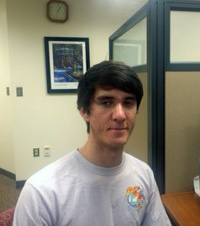Senior Projects 2018
StonesPiece

Students: Marc Acevedo and Andrea Acosta
"StonesPiece" is an iPhone application that aims to allow users to view, record, and
share their performances of the site-specific music piece, "Stones/Water/Time/Breath"
written by Dean Rosenthal, our client. Part of its goal is to extend the reach of
the music piece to the mobile platform. The other part is to create a work space for
musicians interested in this piece to share their own renditions of the piece. This
application will provide information about the piece and its composer as well as a
means for users to create their own performances and upload it to a database with
their location. Along with regular users, an admin user can login to the app and authenticate
each performance uploaded by users all over the world. Each authenticated user uploaded
performance will populate a map with its location for other app users to see. Moreover,
the application will allow for users to sign up for push notifications of new performances.
Hash Function Testing Toolset (HFTT)
Student: Arnold Balliu

This tool was inspired by the work of Dr. Raunak and his colleagues who ran tests on the submissions of the SHA3 competition and found that almost half of them were buggy. NIST, who was in charge of the competition, ran tests as well however they proved to be inadequate. Hash Function Testing Toolset or HFTT is a software application that allows a user to run certain tests on their hash function implementation. These tests serve the purpose of discovering implementation errors or bugs. They employ black box testing techniques which indicate whether the implementation fails or passes. The three tests are called Bit-Contribution test, Bit-Exclusion test and Metamorphic Update test. HFTT is designed to be accessible by everyone who wishes to test their implementation. In addition, it is open source and can be extended to support more hash function families. HFTT is written in C and is cross platform. It makes use of threads to run the tests and each test runs on its own thread to make the most out of available CPU cores.
KELVIN Tool

Students: Christopher Geleta and Michael Latman
Client: Dr. Dawn Lawrie
Our research is focused on improving Johns Hopkins - Human Language Technology Center of Excellence’s natural language processing system: KELVIN. Our tool ties into the KELVIN pipeline. The tool identifies obituaries using machine learning then uses rule based techniques to identify entities and relationships for that obituary.
Community Organizer
Student: Matthew Gray
Client: Action in Montgomery
I’m developing an Android application for a nonprofit organization called Action in
Montgomery (AIM) which does community organizing in Montgomery County, Maryland. The
idea behind the app is to make it easier for AIM to inform its members about events
and other happenings in the community. The app will allow AIM to send mass text messages
to their members to invite them to events, and it will generate trends based on their
responses, such as how many events each member has been invited to, and how many events
each member has RSVP’d yes to.
Emergency Data Research & Analysis Tool

Student: Matthew Heim
Client: Andrew Patton
This application analyzes Emergency system data with the purpose of improvement to the treatment of patients and emergency based protocol. The application analyzes the data provided by emergency technicians after 911 calls in order to help researchers with the improvement of treatments to different types of medical scenarios. The program uses R and python to statistically analyze the data.
Dry-erase Board Usage Tool
Student: William Quintano
Client: Technology Librarian, Mr. Matthew Treskon
 Developed for the Loyola Notre Dame Library, this product tracks the interactions
that patrons have with the library's dry-erase boards. Using this product, the client
can see when and how often each of the boards are being written on. This information
can help library administrators make informed business decisions regarding the inventory
of boards. A series of Raspberry pis and vibrations sensors are fitted to the boards
and constantly supply usage data in real time. Vibrations are translated into usage
events and then stored in a database accessible by the client. To allow for maximum
scalability, several unimplemented features are included in the design. These include
a low battery notification system and a more advanced vibration analyzer that can
distinguish different types of interactions. This product is implemented in Python
and MySQL.
Developed for the Loyola Notre Dame Library, this product tracks the interactions
that patrons have with the library's dry-erase boards. Using this product, the client
can see when and how often each of the boards are being written on. This information
can help library administrators make informed business decisions regarding the inventory
of boards. A series of Raspberry pis and vibrations sensors are fitted to the boards
and constantly supply usage data in real time. Vibrations are translated into usage
events and then stored in a database accessible by the client. To allow for maximum
scalability, several unimplemented features are included in the design. These include
a low battery notification system and a more advanced vibration analyzer that can
distinguish different types of interactions. This product is implemented in Python
and MySQL.
Athletic Equipment Room App
Student: Douglas Robie
Client: Loyola Athletic Department
 My project is an iOS application that utilizes Amazon Web Services on the backend.
The projects main goal is to create an application for the Loyola Athletics Equipment
Room that will effectively communicate information to the users while using database
tables. The application will be able to check the inventory of each team so users
can keep track of what equipment they have. The application will be able to send tasks
to the student workers for them to complete. Users through my application will be
able to send messages to my boss, other workers, or coaches. The application will
also have a unique view depending on whether the user is an admin, a student worker,
or a coach.
My project is an iOS application that utilizes Amazon Web Services on the backend.
The projects main goal is to create an application for the Loyola Athletics Equipment
Room that will effectively communicate information to the users while using database
tables. The application will be able to check the inventory of each team so users
can keep track of what equipment they have. The application will be able to send tasks
to the student workers for them to complete. Users through my application will be
able to send messages to my boss, other workers, or coaches. The application will
also have a unique view depending on whether the user is an admin, a student worker,
or a coach.
Miller Construction

Student: Andrew Serensits
I am working with Miller construction for my senior project. They are a construction
and refrigeration company that has their employees use a website in order to enter
and read data pertaining to their projects. My project will act as quality assurance
for Miller by looking at any “faults” within a project and displaying them to the
user. These faults are defined by rules that Miller follows. This tool will act
as a metric for a project’s status as well as an indicator for which project managers
at Miller need to be more up to date with their data.
Quantitative Model Validation Tool
Student: Michael Setteducati
Research Advisors: Dr. Olsen and Dr. Raunak
 I created an online tool used for Quantitatively Validating a Simulation Model. Dr.
Olsen and Dr. Raunak have created a Quantitative Framework for validating a Simulation
Model in which the model is split into three components: Structural, Behavioral, and
Data. Each component has various validated elements, and each element has relevant
techniques that would have been run on them and an associated success score for that
technique. The success of these techniques are aggregated for component (structural,
behavioral, and data) to compute that component’s confidence score. Then, the confidence
scores of each component are aggregated to compute the overall model confidence. The
online tool implements the calculations and structures defined by this framework to
make it easier for simulation researchers to keep track of their validation efforts
and run the quantitative framework.
I created an online tool used for Quantitatively Validating a Simulation Model. Dr.
Olsen and Dr. Raunak have created a Quantitative Framework for validating a Simulation
Model in which the model is split into three components: Structural, Behavioral, and
Data. Each component has various validated elements, and each element has relevant
techniques that would have been run on them and an associated success score for that
technique. The success of these techniques are aggregated for component (structural,
behavioral, and data) to compute that component’s confidence score. Then, the confidence
scores of each component are aggregated to compute the overall model confidence. The
online tool implements the calculations and structures defined by this framework to
make it easier for simulation researchers to keep track of their validation efforts
and run the quantitative framework.
Senior Projects 2017 Senior Projects 2019 Senior Projects 2020 Senior Project 2021